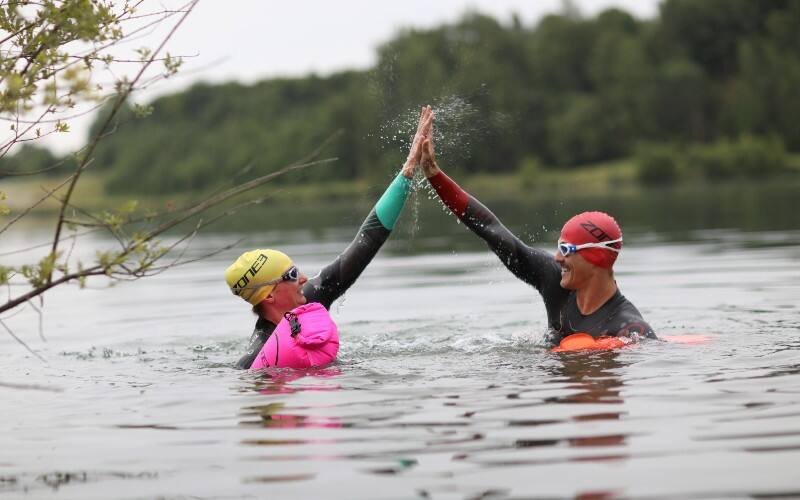Top tips for your first open water event
by Mark Foster

The Benefits of Swimming – Mark Foster
Eight-times World Record holder and Zone3 ambassador, Mark Foster, explains the physical benefits of swimming. Have you ever wondered what muscles you work whilst you swim, or what the different techniques are demanding from your body? Read on to get up to speed on the impact of this super-sport.
There can be no denying that swimming is a seriously energetic sport, using just about every muscle in your body and developing your aerobic fitness levels too. Even better, it burns energy while supporting your joints, making it a great way to condition your body, get in shape, and reduce the risk of injury.
Naturally, I’m all for swimming but I’m not sure everyone knows just how good swimming can be for your health and fitness. So, here’s a breakdown of exactly what happens to your body when you go swimming.
What Muscle Groups are Worked?
Before we get into each stroke, whichever stroke you choose, you’ll be working many of the muscle groups below:
Core Abdominal & Lower Back Muscles:
These are probably the most well-known and talked about muscles so no need to go over old ground, but these work together to keep your body steady and streamline in the water
Shoulder & Upper Back Muscles:
These muscles help the hands have proper entry into the water and extend your reach as well as helping to stabilise your torso in the water and produce the drive. The ones you’ll notice most are around the shoulder area and the best known are the deltoid & trapezius, but there’s many more which sit below these and join the humerus (upper arm bone) to the core & vertebral system. Then there’s the Latissimus dorsi which sits under and below the trapezius.
The Arm Muscles:
These assist in propelling you through the water and aren’t limited to just the biceps & triceps, but also the forearm (brachioradialis & flexor digitorum profundus) and not forgetting the muscles in the hand (Thenars).
Glutes and Leg Muscles:
Ultimately, these muscle groups help push you forward and balance your body on the water. These include the quadriceps, hamstrings, calf (gastrocnemius) and even the muscles around the shin and feet too.
Swim Strokes:
Front Crawl/Freestyle:
Front Crawl is the stroke for speed – it moves you fast through the water and generates the most force. This is the stroke most of you will be familiar with and for those of you who are triathletes, probably the only one you will ever use.
- What’s happening? When you’re using front crawl, your arms are pushing and pulling underwater, your torso is working hard to keep you steady and the rotation it provides can aid in giving you a longer stroke (think about the zipper drill if you’re not getting the most from this). Your hip flexors (at the top of your thighs) are engaged too, to maintain a steady kick.
Backstroke:
Less intensive than front crawl, backstroke is a great recovery option, even if only a few lengths at the end of a session.
- What’s happening? As the name suggests, it works your back. Your lats (Latissimi dorsi) are engaged – that’s the wide muscle on either side of your back, beneath your shoulder blade. This muscle is pulling your arm under the water and then back to the surface again. In addition, your hamstrings (back of your thigh) and glutes (bum muscles) are engaged to propel you through the water.
Breaststroke:
Synchronisation is key here – having the arms in time with the legs. This stroke will work all your muscle groups equally.
- What’s happening? Your shoulders are working hard to move your arms from behind to in front of you. The chest and your lats then work together lift your chest out of the water as you take a breath. Your legs are doing a frog kick that’s similar to leaping off the floor from a squat, working your glutes, quads (front of thigh), hamstring (back of thigh) and your calves, too.
Butterfly:
Butterfly is a super-powerful stroke that will build strength and boost your metabolism.
What’s happening? Both arms move simultaneously, working your shoulders, lats and arms. Your core and lower back muscles go into overdrive to stabilise your core in the water and lift your body out of the water, and your glutes ensure your legs move as one, like a dolphin.
Phew! It’s energising just thinking about it. As far as an all-over body workout goes, it doesn’t get much better. Add to that increased lung capacity from taking huge breaths frequently and precisely, and swimming helps to improve your aerobic performance, too.
There you have it! A walk through of the benefits of each stroke and tips on how to improve each too! The more you know about what muscle groups are demanded for each stroke, the faster you can swim on race day! Why not upgrade your performance with ZONE3’s swim skins, swimwear and swim accessories and receive 40% off your next ZONE3 order with code ZONE3YJN40. Offer expires 14 August 2022.
